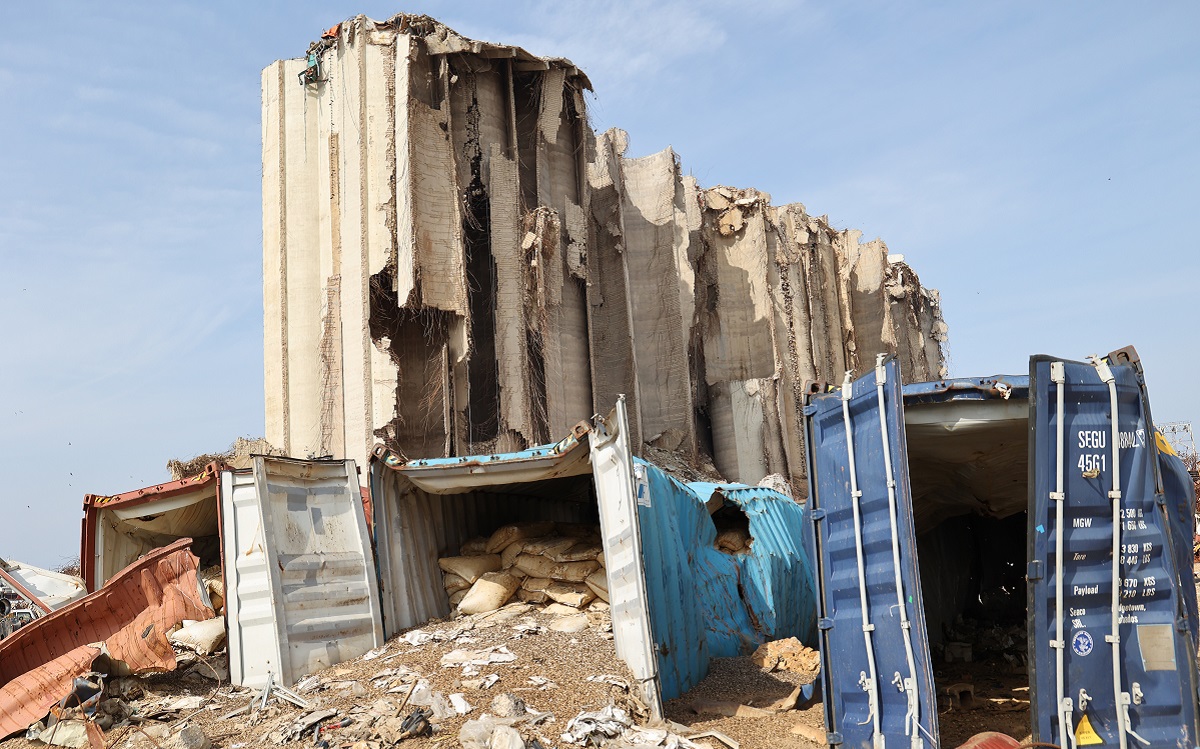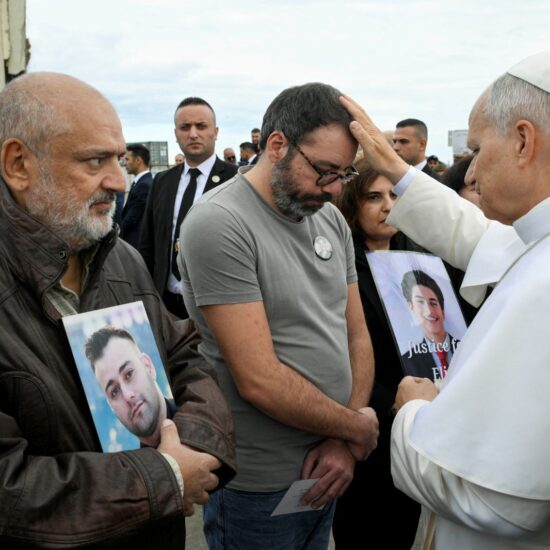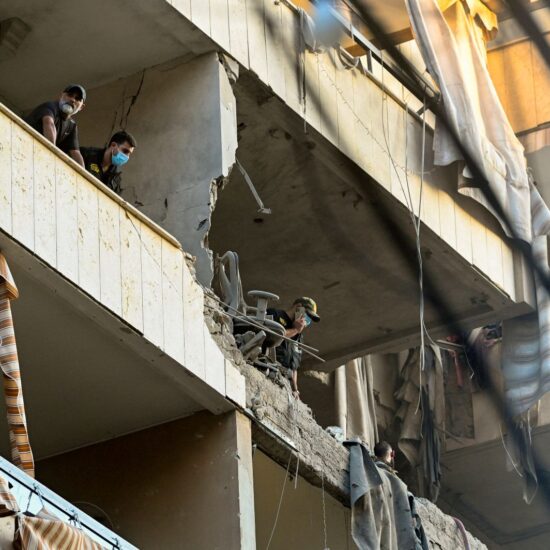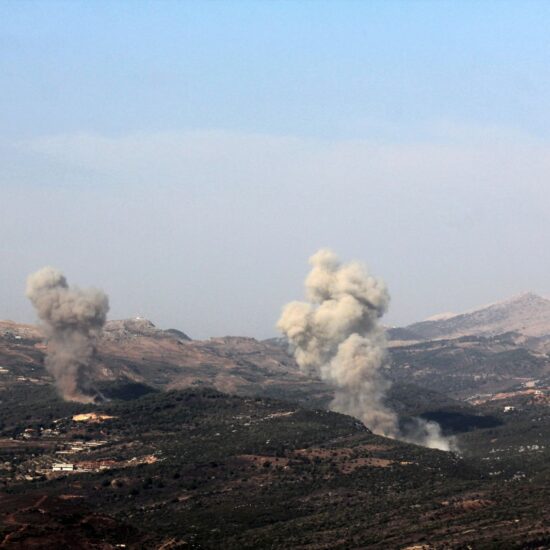
Our loved ones’ spirits are still present, and they are pleading with us to not let them destroy the silos before the truth is brought forward.
A teary-eyed protestor yelled during a demonstration organized on February 20 by the Urban Declaration initiative and families of the Beirut blast victims calling to halt all operations to demolish the ruins of the silos in the Beirut port. The silos and surrounding areas had been severely damaged in the August 4 2020 explosion that killed over 220 people and wounded thousands.
“It’s a crime scene, you can’t demolish them [the silos] before you finish the investigation. People should always be reminded of this mistake so that it’s never repeated again,” Mireille Khoury, mother of 15-year-old victim Elias Khoury told NOW.
But the Lebanese government, as well as some experts, also see the reconstruction of the port as an essential move to put back Beirut on the world shipping map and, thus, to contribute to reviving an economy that has been going through one of the world’s worst crises in 150 years.
In February, Economy minister Amin Salam said in an interview that the government would open the bidding process for companies to demolish the silos and clear the area. On February 17, France’s shipping company CMA CGM, was awarded a contract to develop and operate the container terminal in Beirut for the next 10 years. But it is unclear if that contract also includes demolishing the silos. The information was never made public. The company also acquired in March 2021 Gulftainer Lebanon, the operator of the Tripoli port container terminal, currently the main operational commercial port in Lebanon.
Emmanuel Durand, a Swiss engineer who placed laser monitoring devices on the towers last year, warned that the silos could collapse at any time. Although he said he could not give any predictions regarding a specific time period for the collapse, he noted that the northern part of the structure was more at risk due to its daily tilting ratio. Economy minister Salam voiced the same concerns recently. He said he feared the structure would collapse in the case of a strong storm.
As the government pushes for reconstruction, families and experts say the cabinet is taking a negligent stance to the port’s historical and emotional value. Most Beirutis see the silos as a place of collective memory that should not be taken down before the investigation into the August 4 2020 explosion is concluded. Experts also say that there are ways to arrive at an optimal solution through public consultation, allowing the port to become part of Beirut’s economic and social life. Many fear that the reconstruction, if not done properly, would repeat the mistakes of the past made by Solidere in Downtown Beirut.
“The port should bring a redistributive economy so we need to adopt a modality that can secure this kind of economy. One foreign model adopted by cities like Marseille and Barcelona shows that 30 percent of the port’s income can come back to the city through jobs, cafes, restaurants, bars, tourists,” explained Mona Fawaz, co-founder of Beirut Urban Lab and professor in Urban Studies and Planning at the American University of Beirut.
International interest
The Beirut port attracted international interest with many international companies competing to rebuild it; Russian, Chinese, Turkish, German and French companies have all shown interest in the contract over the past year.
The French shipping group CGA CGM – controlled by the French Lebanese Saade family – said it would invest $33 million in the container terminal.
The deal was met with rejection from the families, who said that no international deals should be made before the investigation was concluded.
“We want international forces to stop meddling with our business, all of you leave us alone, it is up to us, the Lebanese, to decide what to do with our port,” one protester shouted at the protest on February 20.
An earlier German deal submitted by a consortium of German companies led by Hamburg Port Consulting in 2021 was turned down by the Lebanese government. It meant to redevelop the port and create a new residential area from the ruins, with a park and beaches, also creating 50,000 jobs in the process.
In January 2021, the World Bank published a note with recommendations for the Lebanese government in order to set out the conditions under which the international financial body would finance the reconstruction. The note pointed out that Lebanon needs a new governance structure based on the landlord port model, it needs to build efficient and modern customs and transparent border procedures, open a transparent bidding process to select investors, operators, concessionaires and build quality infrastructure.
Mona Tarazi, advanced architectural designer and CEO of Blob architecture, is one of the experts advocating for the preservation of the destroyed silos. If the Lebanese state is to reconstruct the port, and it should, the silos need to be kept.
“They are our memory”, she says, “our cultural heritage”.
She explains that she also advocated for reforming the way the Lebanese state manages the port and awards the contracts. She pointed out that the World Bank recommendations lay out all the proper steps in reforming the port authority in order to handle the reconstruction as a single project with accountability, and not bit by bit. Awarding just the container terminal contract means the government is not looking at the integrated reconstruction of the port, but only at monetizing it.
She also says that, indeed, the silos are in danger of falling by themselves, but only if they are completely neglected. There are always solutions to preserve them inside a comprehensive project of reconstruction that takes into consideration both what the state needs and what the people want, the architect pointed out.
“I had concerns early on that they may fall if not taken care of,” she explained. “We had concerns early on, and they told us much later [that they may fall]. Maybe something could have been done to preserve them in the meantime,” Tarazi added.
So far, Tarazi said, the only comprehensive project that demanded reforming the management of the Beirut port to ensure more accountability was the German proposal. It included the whole port reconstruction, came with a feasibility study and with a financial plan that did not include loans, but investments.
The design could be improved, she said, but there was room for discussion. “They just weren’t given a chance,” she explains.
A part of Beirut
Fawaz said that the port played an essential role in the city’s growth between 1840 and 1943, and established the country’s role as a center of trade.
“If it weren’t for the port, Beirut wouldn’t have played the role it did, Lebanon’s importance relied on the trade going through the port. It was directly connected to the city and it was running as its main engine,” Fawaz told NOW.
The port created all types of employment for the working class, as well as the wealthy.
However, in the post-civil war era, the port was severed from the city, she says. It had its own economy and the spillover onto the city became non-existent. Beirut and Beirutis together stopped benefiting from the presence of the port and its activities. Only the businessmen with control over it were making big bucks.
She said that a lot of factors should be considered before rebuilding, including the port’s future role in relation to Beirut and its inhabitants.
When we reconstructed the historic core of the city we tried to erase everything, we didn’t keep any mark. So the silos become even more important because they’re a memory we can all identify with and recall how it wounded us.
The professor said she did not trust the government’s recent statements regarding the structure’s potential collapse. A similar excuse was used in the 90s in order to justify demolishing buildings in Downtown Beirut.
“They told us that buildings in Downtown Beirut were structurally unsound and needed to be demolished. They brought kilograms of TNT and the buildings would not collapse. They just wanted an excuse to destroy the city and sell the land,” Fawaz said.
Solidere, a real-estate public-private partnership company that emerged after the civil war, was given the responsibility to rebuild post-war Central Beirut. The company performed urban landscaping, supervised the Lebanese government’s reconstruction plan, financed the restoration and rehabilitation of buildings and infrastructure, and constructed new structures for the city.
The city center was transformed into a luxurious, overpriced area with expensive restaurants and designer brands. This “modernization” of the urban area led to complete gentrification. It caused rent and property values to soar, ultimately leading to the displacement of the native working class and poorer communities by ruling class intruders.
Memory and justice
Dzovig Arnelian, 25, an experimental artist who worked in a gallery in the vicinity of the Beirut port, says she survived the explosion on August 4, 2020, with mild physical wounds. She said the silos probably saved her life: they sheltered the city’s western side, where Arnelian worked at the time.
She and other artists say they drew inspiration from the destroyed structure.
“Many artists live in the affected area of Gemmayze and Mar Mikhael. They see the port every day and it became engraved into their memory. Removing them as if nothing happened is totally unacceptable,” Arnelian told NOW.
Instead, she would rather see the silos and the surrounding areas as part of a memorial built to commemorate the victims, which is a popular opinion between experts and families of the victims.
Fawaz considers this kind of monument and commemorative points to possess a characteristic that aids in nation-building.
“Saving heritage has a socio-political component where the city has something to identify with so we begin to identify and share the same story. We become a “we”, instead of remaining islands,” she said.
For the families, the destruction of the silos is part of the politicians’ attempt at escaping responsibility by burying the case and erasing all evidence from the crime scene, while using the pretext of reviving the economy.
For Fawaz, a real-estate deal similar to Solidere did not seem like a viable option. She thought it was too early to comment on the French deal before more details were released, and urged the government to be more transparent with their contracts.
“When we reconstructed the historic core of the city we tried to erase everything, we didn’t keep any mark. So the silos become even more important because they’re a memory we can all identify with and recall how it wounded us,” Fawaz said.
Dana Hourany is a multimedia journalist and producer with @NOW_leb. She is on Instagram @danahourany and twitter @danahourany.








